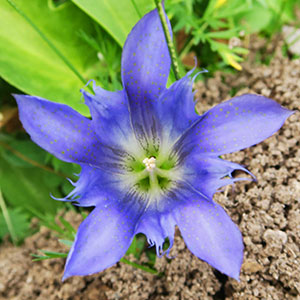Gentiana newberryi
Gentiana fremontii
alpine gentian, Newberry's gentian
Fremont's gentian, moss gentian, moss or Frémont's or lone gentian
1–5, arising laterally below rosettes, from a stout tap root, tufted, decumbent.
1–10(–25), decumbent to erect.
basal and cauline;
blades of basal rosette and proximal cauline leaf blades widely spatulate to obovate or oblanceolate, 0.8–5 cm × 2–25 mm, apex obtuse or mucronate, at least these leaves with blades less than 6 times as long as wide, distal cauline leaves few, with blades oblanceolate to lanceolate or linear, 2–5 cm × 2–5 mm, apices acute.
basal and cauline, cauline leaves gradually smaller, more widely spaced and more strongly ascending distally;
blade conspicuously white-margined, apex acute;
basal blades widely spatulate to ovate or orbiculate, 0.2–1.3 cm × 1.5–8 mm;
cauline blades oblanceolate to linear, distal blades 4–7 × 0.6–2 mm.
terminal, flowers usually solitary, occasionally 2 or 3.
solitary flowers.
calyx 14–30 mm, lobes linear to narrowly ovate, (4–)6–12 mm, margins not ciliate;
corolla white or blue, campanulate, open, 23–55 mm, lobes spreading, elliptic-obovate, 7–17 mm, free portions of plicae divided into 2 triangular, serrate to lacerate segments;
anthers distinct.
calyx 4–12 mm, lobes narrowly oblong-triangular, 1.5–3.5 mm, margins not ciliate;
corolla white to pale blue or rarely deeper blue, often with dark blue lines abaxially, nearly salverform, open, 7–15 mm, lobes lance-ovate, 2–4 mm, free portions of plicae low-triangular with margins entire or shallowly erose-serrate or notched at apex;
anthers distinct.
winged.
not winged.
Gentiana newberryi
Gentiana fremontii
Varieties 2 (2 in the flora).
The two varieties of Gentiana newberryi intergrade extensively. The most distinctive form of var. newberryi, with relatively tall stems and medium to deep blue corollas, occurs in the northern part of the range of the species, from the Klamath and White mountains of California north into Oregon. Plants most clearly referable to var. tiogana prevail in the southern part of the range of the species, from Butte County south to Inyo and Tulare counties, California. In the central part of the range of the species, plant size and corolla color are less consistently correlated, with occasional plants combining low stature with deep blue corollas or tall stems with predominantly white or pale blue corollas. In that part of the range, corolla color may be highly variable within a single population.
The leaves of Gentiana newberryi are thick-textured and distinctively concave, usually spoon-shaped, when fresh. Narrower leaves sometimes occur in var. tiogana, but many plants of that variety have widely spatulate leaves like those of var. newberryi.
(Discussion copyrighted by Flora of North America; reprinted with permission.)
In contrast to the deep green stems and leaves of Gentiana prostrata, the vegetative parts of G. fremontii are much paler. G. Engelmann (1879) described plants of G. fremontii as having a pale, sickly appearance, and J. A. Ewan annotated specimens as having been yellowish when seen in the field, reminiscent of a fungus or broomrape (Aphyllon or Orobanche). This suggests that mycorrhizal symbiosis is especially significant in this species, but its trophic ecology has not been studied.
Gentiana fremontii differs further from G. prostrata in having obovoid capsules less than twice as long as wide, generally not fully exserted from the marcescent corolla, narrowly winged distally along the sutures, with valves that eventually separate nearly to the base, whereas the capsules of G. prostrata are compressed-cylindric, more than twice as long as wide, often fully exserted at maturity, not winged, with the valves separating only above the middle. Also, although both species vary in this respect, G. fremontii more often has the flower parts in fives.
The names Gentiana aquatica Linnaeus and Chondrophylla aquatica (Linnaeus) W. A. Weber have often been applied to this species. Gentiana fremontii, although similar to the Siberian and Chinese G. aquatica, appears to differ consistently in the wider, more conspicuous white margins of its leaves, longer and proportionately narrower mid-cauline leaves, usually white rather than blue corollas, and corolla plicae that generally have jagged rather than entire summits. The illegitimate name G. humilis Steven 1812, not Salisbury 1796, has also been applied to G. fremontii, but the North American plants are not now considered conspecific with the type from Azerbaijan.
(Discussion copyrighted by Flora of North America; reprinted with permission.)
1. Corollas medium to deep blue with greenish to dark purple lines abaxially on and below lobes, usually 35–55 mm. | var. newberryi |
1. Corollas white to pale blue except for greenish to dark purple lines abaxially on and below lobes, usually 23–42 mm. | var. tiogana |


